Foreword

Throughout 2022 we experienced an increase in extreme weather events, such as significant aridity in the summer months and heavy rainfall leading to floods across Europe in autumn and winter. The impact of climate change can already be felt and is only expected to increase in the future. The European Central Bank (ECB) recognises its role in supporting an orderly transition to a climate-neutral economy. It also recognises the importance of continuing to drive positive change by reducing its own impact on the environment.
We are therefore taking action on many fronts, including in our day-to-day activities. In 2022 we reached several milestones that bring us closer to fulfilling our commitment to reducing our carbon emissions in line with the 1.5 degrees Celsius trajectory outlined in the Paris Agreement. This translates into a 46.2% reduction in our organisational carbon footprint.
To further decarbonise the operations of the ECB buildings, the heating source for the Eurotower was replaced by a renewable alternative – biogas instead of natural gas – resulting in considerable environmental gains. In addition, the ECB implemented various energy-saving measures in 2022 to actively support the European Union’s efforts on short-term energy conservation. These measures led to an 18.6% reduction in heating and cooling energy compared with the previous year.
Like many organisations, over the past year the ECB has rethought its way of working and has introduced a new teleworking policy. This seeks to strike a balance between providing staff with flexibility on where they work and fostering collaboration and social interaction. As of May 2022 our staff members gradually returned to the offices, repopulating the ECB’s buildings. Occupancy of these buildings had been very low throughout the pandemic years, as staff had been asked to work from home to help slow the spread of COVID-19. The gradual withdrawal of pandemic-related restrictions led to an increase in the take-up of all services offered onsite, ranging from meals served in the ECB’s staff restaurants to cleaning services. In addition, travel activities resumed after having been on hold for almost two years. These included business trips not only by ECB staff but also by external colleagues travelling to the ECB for meetings and conferences. In order to manage the associated emissions and mitigate the rebound of emissions to pre-pandemic levels, various environmental objectives and measures were put in place under the latest Environmental Management Programme, such as the restriction of business travel-related emissions to 60% of 2019 levels.
Fostering collaboration and engagement remained a guiding principle of our strategic environmental work, both within and outside the ECB. The ECB reaffirmed its commitment to the environment by increasing its internal and external communication. Within the organisation, this included running an environmental competition and staging an awareness-raising campaign on sustainable mobility. At the same time, the ECB deepened its valuable channels of exchange with other official institutions.
Looking to the future, we will continue to honour our commitments to stepping up our sustainability and climate protection efforts. Together with all staff members, I am looking forward to the road ahead as we strive to meet the goals of the Paris Agreement and the European Union’s climate neutrality objectives. Along the way, we will continuously monitor and adjust our actions to ensure that we stay on track by achieving our intermediate targets.
Luis de Guindos
Vice-President of the European Central Bank
1 The year in figures
Figure 1
2022 highlights

Source: ECB.
Figure 2
2022 in figures
(2022 figures and percentage changes from 2021 to 2022 and from 2019 to 2022)

Source: ECB.
Note: Developments in environmental data by workplace in 2022 are included in Chapter 5 ‒ Technical information.
Further details on all these developments are provided in Chapter 4 – Environmental aspects and impact of the ECB’s activities.
2 Environmental management at the ECB
2.1 Organisational context

At the start of 2022, the COVID-19 pandemic continued to affect the daily operations of the ECB, as staff attendance at its premises was still impacted by travel restrictions, social distancing requirements and remote working practices. From May onwards, the restrictions and security requirements were gradually lifted, resulting in a larger number of ECB staff members returning to the offices or traveling for business compared with the previous years. To avoid a sharp increase in emissions following the pandemic, internal guidelines aimed at containing business travel emissions and limiting the environmental impact of travel by conference participants to the ECB had already been drawn up in 2021. Although business travel activities increased in 2022, leading to an expected rebound effect, the emissions resulting from business travel were still 64% lower than before the pandemic in 2019 (see Chapter 3.2 - Indirect emissions for more details).
Reducing emissions and contributing to combating climate change on an organisational level continues to be of major importance to the ECB. In the light of the European and German guidelines and regulations on energy efficiency, many measures were introduced to achieve additional energy savings as of summer 2022. Going forward, changes in the organisational environment, including associated opportunities and risks, as well as stakeholder expectations, will continue to be significant inputs in developing the ECB’s environmental management system (EMS), including its objectives and measures.
Beyond the scope of the EMS, the ECB is committed to doing its part to address climate change through its activities to maintain price stability in the euro area and contribute to the safety and soundness of the European banking system, within its mandate. In 2021 the ECB established the climate change centre (CCC), which is responsible for designing and steering the ECB’s strategy on climate and advancing climate-related work in collaboration with relevant internal and external stakeholders, including at Eurosystem level via the relevant committees and fora. In its role steering and coordinating work on climate change related issues, the CCC has developed the ECB climate agenda, which contains the planned priority areas and actions, and has published this on its new external webpage on Climate change and the ECB. The agenda focuses on the three main objectives that steer the ECB’s work on climate change: managing and mitigating the financial risks associated with climate change and assessing its economic impact, promoting sustainable finance to support an orderly transition to a low-carbon economy, and sharing its expertise to foster wider changes in behaviour. The ECB’s EMS contributes to this last objective by reducing the organisation’s own environmental impacts and being transparent about its environmental performance in the annual Environmental Statement.
The ECB reports yearly on its key work on climate in both the ECB’s Annual Report and the Annual Report on supervisory activities, in addition to the regular publications on its external website. In 2023, together with the Eurosystem central banks, the ECB has also published for the first time the climate-related financial disclosures of the Eurosystem’s corporate sector holdings for monetary policy purposes and its non-monetary policy portfolios.
2.2 Overview of the environmental management system

The ECB’s Environmental Statement 2023 highlights the environmental data for the three buildings that fall within the scope of the EMS: the ECB’s own main building, as well as the leased assets in the city centre of Frankfurt – the Eurotower and the Japan Center. Since 2018 the ECB has occupied all available office space in the three buildings.
As the buildings follow different construction standards and were built in different years, the data on the main building are reported separately from the aggregated data on the city centre premises to assess the environmental performance of the buildings.
For its EMS, the ECB follows the three-year reporting cycle of the European Union’s Eco-Management and Audit Scheme (EMAS) standard. This year’s Environmental Statement is the first update of the ECB Environmental Statement 2022.
The ECB’s environmental policy describes the ECB’s commitment to protecting the environment and its strategic priorities for improving its environmental performance. Further information on the ECB’s environmental policy and the governance of its EMS is available on its website.
3 The ECB’s carbon footprint


Note: Developments in 2022 were still influenced by the pandemic and related developments, such as travel-related restrictions.


Note: “Completed” = measure completed; “In progress” = measure in progress; “Pending” = measure still to be implemented.

The ECB’s carbon emissions are calculated in alignment with the Greenhouse Gas Protocol framework, according to which direct and indirect emissions are allocated to scopes 1, 2 and 3. The carbon footprint boundary remains unchanged compared to the ECB’s previous Environmental Statement following a considerable scope 3 extension exercise in 2021. The components of the ECB’s current carbon footprint are shown in Figure 3.
Figure 3
Components of the ECB’s carbon footprint

Source: ECB.
In 2022 total emissions remained relatively stable compared with 2021 (Chart 1). However, significant changes were observed in the individual scopes. Scope 1 emissions have decreased considerably since the heating source in the Eurotower was changed from natural gas to biogas. This is reported under scope 2 in line with the Greenhouse Gas Protocol framework.
Compared with 2021, scope 2 emissions increased by 9.7% owing to increased occupancy of the buildings as staff returned to their offices in 2022 and the related increase in district heating. This increase in scope 2 emissions was partly offset by energy-saving measures implemented as of 1 September 2022 in line with the German government’s short-term energy-saving ordinances.[1] Scope 3 emissions increased by 25.2% compared with 2021 owing to increases in business travel and travel by conference participants to the ECB following the end of pandemic restrictions. However, the level of scope 3 emissions is still well below pre-pandemic levels. Overall, the ECB’s reported emissions decreased by 0.2% between 2021 and 2022.
Chart 1
Total CO2e emissions ‒ scopes 1, 2 and 3
(tonnes CO2 equivalent)
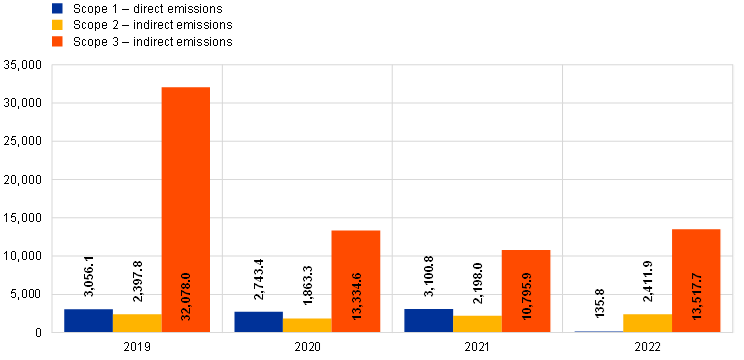
Source: ECB.
Note: Scope 3 values were adjusted from 13,334.5 to 13,334.6 tonnes CO2e for 2020 and from 10,724.4 to 10.795,9 tonnes CO2e for 2021 due to updates of the database.
While avoiding emissions and reducing the carbon footprint remain the ECB’s key priorities, as a remedial measure the ECB also offsets its unavoidable emissions. The ECB has been purchasing Gold Standard and Verified Carbon Standard-certified carbon credits to offset its reported greenhouse gas emissions since 2018. The chosen carbon credits contribute to sustainable projects worldwide. In 2022 the credits purchased to offset the 2021 residual carbon footprint supported the installation of boreholes to ensure access to clean drinking water, thereby contributing to improving the health and well-being of local communities. It also supported a project to give access to clean and affordable energy through the regional development of a windfarm. To continue this practice, the ECB is currently preparing a public procurement process to compensate for its residual carbon emissions from 2022.
Emissions from certain goods and services purchased by the ECB are already compensated by the suppliers and service providers themselves, for example part of the purchased office paper and upstream emissions from train travel within Germany that are covered by the related certificate[2]. From 2022, and retrospectively to 2019, emissions from the compensated office paper are accounted for within scope 3 and additionally displayed outside the scopes.
Chapter 5 ‒ Technical information provides more information on the relevant data.
3.1 Emissions related to the operation of ECB premises
Direct emissions (scope 1) and indirect emissions from purchased energy (scope 2) associated directly with the operation of the ECB’s premises arise mainly from heating and cooling energy consumption and fuel use. In 2022 these emissions accounted for 15.9% of the ECB’s total carbon footprint. Upstream emissions from all energy sources are reported under scope 3 and described in Chapter 3.2 ‒ Indirect emissions. Electricity consumption-related emissions (included under scope 2) are accounted for as zero under the market-based approach, as the ECB has been using 100% renewable energy sources for its buildings since 2016. However, improving energy efficiency and reducing energy consumption remain main targets of the ECB’s EMS.
Chart 2
CO2e emissions ‒ scopes 1 and 2
(tonnes of CO2 equivalent)

Source: ECB.
3.2 Indirect emissions
Indirect emissions (scope 3) accounted for a total of 84.1% of the ECB’s carbon footprint in the reported year. Chapter 4 ‒ Environmental aspects and impacts of the ECB’s activities describes the specific changes in scope 3 emissions in 2022.
Business travel and hotel stays
From May 2022 pandemic-related restrictions on business travel were gradually lifted. As a result, emissions from hotel stays and business travel increased more than tenfold in 2022 compared with the previous year but remained well below 2019 levels. This development risks causing a sharp increase in CO2e emissions from business travel in the future compared with the years affected by the pandemic. To avoid a rebound effect in emissions, the ECB has set a target to limit annual travel-related CO2e emissions to a maximum of 60% of 2019 levels between 2022 and 2024. In 2022 business travel emissions reached 35.8% of 2019 levels. The sharp increase in emissions from business travel highlights the importance of closely monitoring this trend and the need to set ambitious targets early on in order to achieve a permanent reduction in business travel emissions.
Emissions from business travel include Well-To-Tank (WTT) emissions[3] for all fossil fuel-based transport and considers the Radiative Forcing Index (RFI) factor for air travel.[4] The ECB follows a best practice approach by measuring both RFI and WTT emissions to provide a broad overview of the environmental impact of its travel emissions. This category also includes emissions from hotel stays. For more information, see Chapter 4.9 ‒ Travel.
Travel by conference participants
The ECB’s carbon footprint also includes emissions from travel by participants to conferences and events held at the ECB premises. To calculate these emissions, the RFI-factor for air travel and WTT emissions for fuel-based transport options are taken into account. Although it is likely that delegates’ business travel is double-counted, and despite the ECB’s low influence on the means of travel used by external delegates, it was decided to include these emissions in the carbon footprint during the scope 3 extension exercise in 2021. It is acknowledged that calculating these emissions requires making a large number of estimations and assumptions owing to data quality issues. However, the ECB monitors these emissions and is aiming to contain rebound effects following the lifting of pandemic-related restrictions by upholding its objective to limit the number of conferences and meetings held at the ECB with external conference participants to 50% of total events. Chapter 4.9 ‒ Travel describes developments in 2022.
Staff commuting and teleworking
Most ECB staff worked remotely in 2020, 2021 and partly in 2022 owing to the pandemic. This meant that a portion of energy consumption was shifted from ECB premises to staff homes. The ECB therefore decided to include emissions from teleworking in its carbon footprint boundary under the category “Emissions from staff commuting”. In 2021 the ECB conducted its biennial detailed staff survey to assess emissions stemming from teleworking and commuting. In 2022 this data was complemented with occupancy rates for the buildings, and other factors were used to enhance calculations of teleworking emissions. The survey included emissions from energy consumption for office equipment, lighting, heating and cooling. In addition, the survey provided information on changes in emissions from employee commuting during the pandemic. Based on the survey responses, emissions for teleworking amounted to 631.1 tonnes CO2e in 2022, a decrease of 37.1% compared with 2021. Emissions from commuting amounted to 1,134.0 tonnes CO2e in 2022 representing a decrease of 11.5% compared with the previous year. However, it is important to note that the conclusions and magnitude of environmental impacts associated with commuting and teleworking should be interpreted with caution owing to the inherent limitations and necessary underlying assumptions of a survey-based approach. Further information on the survey approach is available in Chapter 4.9 ‒ Travel.
Waste
Between 2019 and 2022 the ECB continuously reduced emissions from the disposal of waste on its premises. However, as more staff returned to working on-site in the course of 2022, emissions from waste disposal rose by 39.8% compared with the previous year. More detailed information can be found in Chapter 4.5 ‒ Waste and recycling.
Purchased goods and services
This category includes the following emission sources: catering and cleaning services, external printing services, information and communications technology (ICT) services, gardening services, office supplies and stationery, paper consumption for office purposes, ECB publications and other paper items, electricity consumption at the external data centre, and fresh and waste water.
Emissions from catering services are calculated based on the lifecycle emissions of the ingredients, taking into account aspects such as transport. Gardening services emissions are estimated based on fuel consumption during gardening activities. Emissions from printing services include electricity consumption and paper-related emissions. Owing to a lack of available consumption data, the ECB reports on emissions from office supplies and stationery as well as emissions from cleaning services based on value-based emission factors. Emissions from ICT services are calculated based on the duration of videoconferences conducted by ECB staff.
Overall, emissions from purchased goods and services represented 9.3% of total scope 3 emissions in 2022. As staff returned to the offices and on-site service activities picked up, emissions from purchased goods and services increased by 30.2% from 2021 to 2022. Emissions from fresh and waste water steadily decreased between 2019 and 2021. However, this trend was interrupted in 2022, when higher building occupancy led to an increase of 25.1% compared with the previous year. Further information can be found in Chapter 4.3 ‒ Material efficiency and Chapter 4.4 ‒ Water and waste water.
Chart 3
CO2e emissions ‒ scope 3
(tonnes CO2 equivalent)

Source: ECB.
Notes: Business travel includes emissions from business-related trips by bus, train or plane and hotel stays. Emissions from purchased goods and services were adjusted for 2020 from 1,187.1 tonnes CO2e to 1,187.2 tonnes CO2e and for 2021 from 945.3 tonnes CO2e to 961.1 tonnes CO2e. For 2021 waste emissions were adjusted from 8.7 tonnes CO2e to 6.4 tonnes CO2e, and emissions from other assets from 974.9 tonnes CO2e to 1,032.9 tonnes CO2e. These changes were necessary owing to updates of the database.
Chart 4
Breakdown of scope 3 emissions
(percentages of CO2e emissions)

Source: ECB.
Beyond CO2e emissions, the ECB keeps track of and reports on other emissions produced as a result of its activities. These encompass the quantities of sulphur dioxide (SO2), nitrogen oxides (NOX) and particulate matter (PM) released by the ECB’s vehicle fleet and emergency power unit test runs. In alignment with the requirements of the Greenhouse Gas Protocol, the ECB now also accounts for biogenic emissions[5] outside of scopes 1, 2 and 3 in relation to its biogas consumption. Chapter 5 – Technical information provides more information on the relevant data.
4 Environmental aspects and the impact of the ECB’s activities
4.1 Update of the environmental aspects assessment
The ECB assesses direct and indirect environmental aspects based on its ability to influence the aspects and their significance for the ECB’s environmental performance. Compared with previous years, the impact of the COVID-19 pandemic on the ECB’s operations decreased throughout 2022. However, it has had a long-term impact on the ECB’s way of working. A new teleworking policy has been established, which increased recurrent staff presence on-site to a minimum of 110 office days per year. To limit the resurgence of emissions and environmental impacts from business travel and conference participants travelling to the ECB following the gradual lifting of pandemic-related mobility restrictions, applicable measures and goals have been set in the Environmental Management Programme (for more details, see Chapter 3 ‒ The ECB’s carbon footprint).
The energy-saving measures implemented in line with the short-term energy-saving regulation by the German government led to significantly lower energy consumption of the ECB’s premises. Overall, there were no drastic changes to the environmental aspects, as most developments, for example teleworking and business travel emissions, were impacted by effects related to social distancing regulations.
Figure 4
Assessment of the ECB’s direct environmental aspects

Source: ECB.
Notes: There were no cooling agent losses in 2022 in the city centre premises or in the main building. This is why the environmental significance in the city centre decreased from A to B. In addition, drip pans were installed in the Eurotower to detect future losses at an earlier stage and the number of cooling machine inspections conducted throughout the calendar year was increased. The ability to influence of heating and cooling measures was changed from II to I in the main building and from III to II in the city centre since decreasing the office temperature led to high energy savings. The significance of total CO2e emissions from heating and cooling in the city centre was changed from A to B as a result of the switch from natural gas to biogas.
Figure 5
Assessment of the ECB’s indirect environmental aspects

Source: ECB.
Notes: Total CO2e emissions from business travel: air travel increased from 2021 to 2022 and nearly reached the level of emissions in 2020. This is why the significance of business travel by air was increased from C to B. Conference participant travel emissions rose owing to an increase in in-person conferences with external counterparts, which led to the change in the ranking from C to B. Owing to the decrease in the environmental impact from teleworking emissions, the significance was changed from B to C. The significance of the environmental performance of catering companies was increased from C to B because the number of meals served grew as more staff members returned to working on-site.
4.2 Energy efficiency


Note: The 2022 status is influenced by energy-saving measures implemented to contribute to Germany's energy-saving efforts.


Note: Completed = measure completed; in progress = measure in progress; pending = measure still to be implemented.
1) European Court of Auditors.

Energy consumption at the ECB’s buildings decreased by 6.7% in 2022 compared with the previous year and was 18% lower than in 2019. Although staff have returned to the premises, it has still been possible to lower energy consumption. This is due to the energy-saving measures implemented in line with the German federal government’s energy-saving regulation. However, the ECB recognises that part of the energy consumption remains deferred to staff homes as a result of teleworking.
To further reduce energy consumption on the ECB’s premises, several energy efficiency measures were implemented, such as lowering set heating points in offices and extending the automatic lighting switch-off schedule during the night and at weekends. In addition, the ECB is striving to identify further potential savings by participating in a local energy efficiency network and took part in alignment exchanges on energy-saving measures at the Eurosystem level.
The ECB recognises that changes in working environments and modalities affect environmental aspects and is thus continuously exploring the need to adjust its approach accordingly. For example, with regard to the environmental impact of cloud services, the ECB is currently evaluating its ability to measure this effect and explore market best practices.

Compared with the previous year, in 2022 the use of electrical energy increased by 3.5%, while heating and cooling energy consumption decreased by 17.9%. Owing to the rising number of employees working on-site, in line with expectations, the amount of biogas used for cooking in the main building’s kitchen increased by 76.1% compared with 2021. In 2022 the ECB’s canteen returned to a pick-and-weigh system to avoid food waste, allowing staff to decide on portion sizes. As a result, it is no longer possible to report on the number of meals provided.
In previous years, an energy consumption dashboard was developed to track weather-adjusted energy consumption at the main building in real-time and based on an additional forecasting feature, to steer building management accordingly. In 2022 this dashboard was used to great advantage to track the savings achieved through energy-saving measures such as the reduction in office temperatures.

In the city centre premises, electrical energy consumption increased by 3.1% compared with 2021. By contrast, energy consumption for heating and cooling decreased by 19%.
In 2022 the heating source in the Eurotower was changed from natural gas to biogas. The consumption of biogas decreased by 20.08% compared with the natural gas consumption used for heating in 2021 as a result of the energy conservation measures. In the Eurotower, two cogeneration plants generate heat and electrical energy by means of biogas (formerly natural gas) through which the amount of purchased energy is reduced.
The consumption of district heating also fell by 15.8% in the Japan Center compared with the previous year. By contrast, electricity consumption remained relatively stable and increased slightly by 1.2%. Energy measures such as the gradual replacement of lighting with LEDs are implemented to continuously increase energy efficiency. Also, three cooling machines were replaced by more energy-efficient models in 2022 and a fourth cooling machine was installed in January 2023. This is expected to lead to a significant decrease in energy consumption for cooling.
Chart 5
Energy consumption ‒ main building
(MWh)

Source: ECB.
Chart 6
Energy consumption ‒ city centre buildings
(MWh)
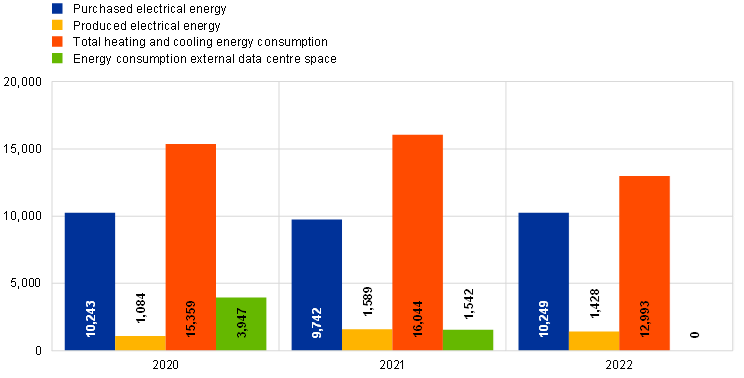
Source: ECB.
For more information on greenhouse gas emissions associated with energy consumption, see Chapter 3.1 – Emissions related to the operation of ECB premises.
4.3 Material efficiency




Note: Completed = measure completed; in progress = measure in progress; pending = measure still to be implemented.
The ECB is continuously working towards its target to eliminate all single-use plastic items in customer-facing outlets and kitchen operations by 2024. Various measures to reduce packaging were successfully implemented in cooperation with the catering service, such as the elimination of single-use plastic take-away containers. The ECB continues to explore options to reduce individual packaging of food and cutlery. For example, in 2022 approximately 2,500 wooden stir sticks were saved by replacing them with steel coffee spoons in the staff restaurants and bistro in the main building. In the Japan Center and the Eurotower restaurants, disposable packaging made from sugar cane is less visible and must be requested by guests, while circular alternatives are offered in return for a deposit as first choice. A meat-free day per week was introduced in all staff restaurants, and vegan and vegetarian choices are offered more frequently and prominently. In order to raise awareness about the environmental impact of food choices, information on the carbon footprints of the meals is provided by means of signs next to the dishes. This measure has now been permanently implemented following a successful pilot project in 2021. In March 2022, as in previous years, the caterers also took part in the World Wildlife Fund’s Earth Hour. In addition, an interactive exhibition on the carbon footprint of food was displayed in the main building in cooperation with the City of Frankfurt and the ECB’s caterer from August to September 2022.
In 2022 the ECB also established an in-house print centre, improving the sustainability of its printing activities, for example by establishing an on-demand service reducing potential waste from larger orders that resulted from the minimum order requirements applying previously. QR-codes were introduced on permanent business cards to reduce the amount of paper business cards. Additionally, to reduce printing and related materials, 100 on-floor printers were removed from all three ECB buildings, representing about 30% of all on-floor printers.
The following sections describe in more detail the resource consumption arising from publications, office paper, cleaning agents, office supplies and chemicals for water treatment and cooling. Information on the associated CO2e emissions can be found in Chapter 3.2 ‒ Indirect emissions (subsection on purchased goods and services).
4.3.1 Publications

Paper consumption for official ECB publications fell by 0.31 tonnes in 2022, leading to a decrease of 95.0% compared with 2021. However, as illustrated in Chart 7, paper consumption for ECB publications fluctuates, as it is determined by the volume of external communication campaigns. However, it is noteworthy that consumption in 2020, 2021 and 2022 remained well below one tonne, in contrast to the figures for former years.
Chart 7
Paper consumption for official publications
(tonnes)

Source: ECB.
4.3.2 Office paper

The ECB was able to improve its environmental impact by reducing office paper consumption by 84.7% compared with 2021. This sharp reduction stemmed from the increasing digitalisation of processes and digitisation of paper-based documentation. Compared with 2019, office paper consumption decreased by around 93.3%.
The share of recycled paper in the remaining paper consumption decreased. While it amounted to 99.3% in 2021, the share of recycled paper was only 3.5% in 2022. This development can be explained by the steep decline in paper consumption. Supply chain disruptions and price developments on the market also affected the availability of recycled paper. However, a corrective action plan has already been agreed upon to increase this share again.
Other paper products, mainly calendars, accounted for about 3% of the ECB’s paper consumption. Except for A0 wall calendars, all print products have been produced on-site since the summer of 2022 in order to better control energy and resource consumption from printing activities.
Chart 8
Office paper consumption
(thousands of sheets of A4 equivalent)
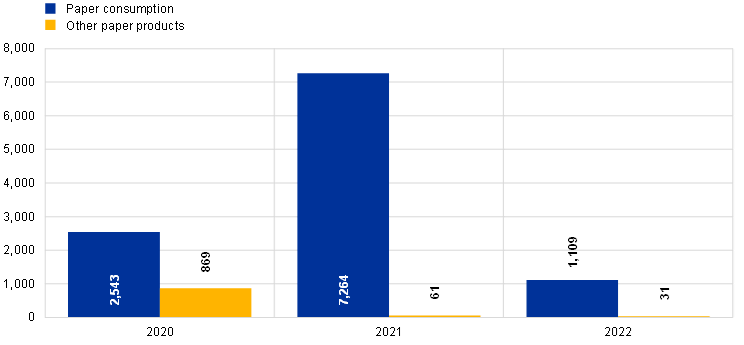
Source: ECB.
4.3.3 Cleaning agents

In 2022 the ECB used biodegradable, microbiological cleaning agents. In addition, surface disinfection was carried out using aqueous ozone. Overall, the consumption of cleaning agents in the main building and city centre buildings increased significantly compared with 2021 by around 177% and 253% respectively. This increase was driven by the need to clean more frequently owing to higher building occupancy. However, consumption decreased 40.9% and 53.9% respectively compared with 2019. The use of disinfectants also increased in comparison to 2021, but is lower than in 2020.
Chart 9
Cleaning agent consumption
(tonnes)

Source: ECB
4.3.4 Office supplies

Environmental labels are illustrated in the ECB’s stationery catalogue to steer staff towards making less environmentally impactful choices. In both 2021 and 2022, 38% of the stationery in the catalogue was labelled eco-friendly. Work is ongoing to further increase the share of eco-friendly stationery in the catalogue.
Staff members continue to have the possibility to return unused stationery and other office materials to the logistics storeroom so that these items can be re-used. A dedicated campaign was launched to limit an increase of stationary orders as staff returned to the offices and to make staff aware of the alternatives on offer. Subsequently, material efficiency topics were also included in the Road to Paris staff campaign. For further information, see Chapter 4.10 ‒ Communication, engagement and awareness-raising.
4.3.5 Chemicals for water treatment and cooling agents

Chemical consumption for water treatment, mainly consisting of salt for water softening, increased in 2022. While the increase in the main building was 43.2%, chemical consumption in the buildings in the city centre increased by more than 2.5 times (+163.0%), both as a consequence of higher building occupancy. In 2022 the use of chemical substances for water treatment was in a similar range to that in 2019. Furthermore, no cooling agent losses were detected in any of the ECB’s premises. However, efforts to prevent leakages were established in 2022 to prevent future losses and detect potential leakages in the Eurotower at an earlier stage.
Chart 10
Chemicals used for water treatment
(tonnes)

Source: ECB.
Chart 11
Cooling agent losses
(kilograms)
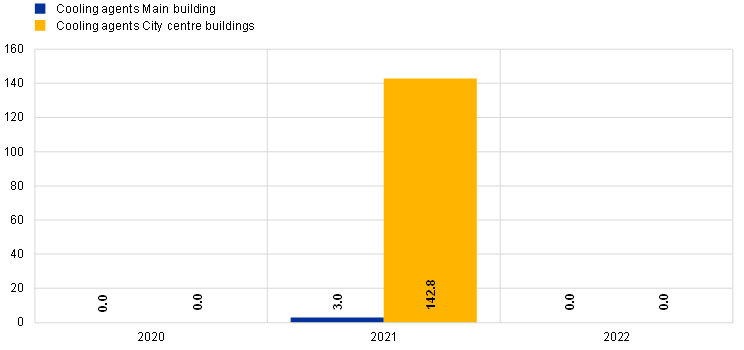
Source: ECB.
4.4 Water and waste water

Water consumption in the ECB’s premises includes technical and non-technical water. Technical water is consumed by processes within the building for temperature control, whereas non-technical water consumption arises from kitchenettes, canteens and sanitary facilities. Non-technical water from the main building includes gardening water for the irrigation of trees. This effect needs to be considered when comparing the non-technical water consumption of the main building with that of the city centre premises.

Fresh water consumption in the main building increased by 41.4% in 2022 compared with 2021 owing to increased staff presence on-site. Technical water consumption increased by 179.0% and non-technical water consumption by 13.2%. A part of the non-technical water consumption arises from the maintenance of the green areas. For greenkeeping at the main building and for sanitary facilities on the lower floors, the ECB uses some of the rainwater collected on the roof of the Grossmarkthalle to reduce fresh water consumption. Despite the increase from 2021 to 2022, total fresh water consumption decreased 58.7% compared with 2019 as a result of several water-saving measures, such as irrigation bags for trees, and lawns were not watered during the summer months.

Compared with 2021, fresh water consumption at the city centre premises increased by 5.2%, whereas technical fresh water consumption decreased by 1.9% and non-technical fresh water increased by 8.3%. Total fresh water consumption at the city centre premises remained relatively stable throughout 2020 and 2021, but dropped by 29% compared with 2019.
See Chapter 3.2 ‒ Indirect emissions (subsection on purchased goods and services) for more details on CO2e emissions related to water and waste water.

Chart 12
Water consumption ‒ main building
(m³)
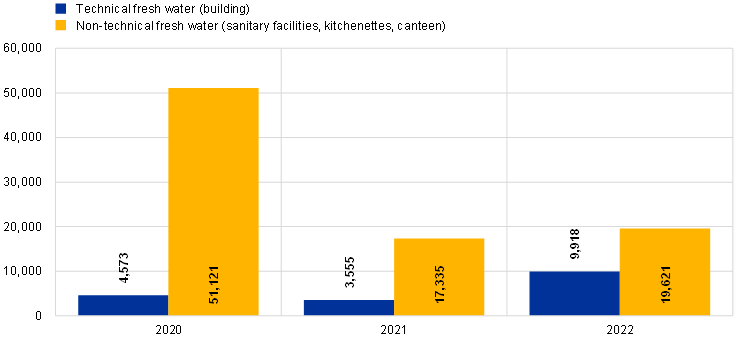
Source: ECB.
Chart 13
Water consumption ‒ city centre buildings
(m³)

Source: ECB.
For more information on greenhouse gas emissions associated with water and waste water, see Chapter 3.2 ‒ Indirect emissions (purchased goods and services section).
4.5 Waste and recycling




Completed = measure completed; in progress = measure in progress; pending = measure still to be implemented.

In order to reduce the environmental impact of waste generation, avoiding and reducing waste are among the ECB’s environmental targets. To reach its target of obtaining a 5% reduction in residual waste per workplace in 2023 relative to 2018 levels, collaboration and awareness-raising measures among both staff and service providers were implemented in 2022.
Owing to higher building occupancy in 2022, waste amounts increased by 50.3% compared with 2021. Non-hazardous waste, which includes components such as plastic packaging, organic waste, residual waste, confidential paper waste, and paper and cardboard, accounted for 90.3% of total waste generation. Hazardous waste accounted for 9.7% of total waste generation, reaching 51 tonnes in absolute amounts. Hazardous waste includes the subsections electronic waste (4.2 tonnes) and other hazardous waste (46.8 tonnes), which mainly consists of batteries. In 2022 the ECB reduced its IT waste by participating in programmes targeting the re-use of IT equipment. In principle, furniture and technical equipment are re-used as far as possible.

Total waste generation at the main building increased by 34.2% in 2022 in comparison to the previous reporting period. Notably, there was an increase in the volume of all categories of waste. This is because greater on-site staff presence resulted in higher consumption of packaged products at the ECB’s premises. Organic waste, which also includes grease separator waste, increased drastically from 2021 to 2022. The increase of 81.4% reflects higher demand in the staff restaurants. However, the ECB decreased its total amount of waste from the main building by around 42.5% compared with 2019.

Waste generated at the city centre premises also increased by 85.1% in 2022 compared with 2021. However, changes in the individual waste categories varied greatly: waste from confidential paper and packaging decreased (-43.7% and -62.6% respectively), whereas paper and cardboard waste (+147.1%), residual waste (+217.7%) and organic waste including grease separator waste (+191.0%) increased. These increases are due to higher demand for services from kitchens and kitchenettes. Compared with 2019, the ECB decreased its total waste amounts generated at the city centre premises by 47.5%.
Chart 14
Waste and recycling ‒ main building
(tonnes)

Source: ECB.
Chart 15
Waste and recycling ‒ city centre buildings
(tonnes)

Source: ECB.
Note: For more information on greenhouse gas emissions associated with waste, see Chapter 3.2 ‒ Indirect emissions.
Table 1
Breakdown of waste types in accordance with the German Commercial Waste Ordinance

Notes: Waste amounts displayed in Table 1 partly differ from amounts displayed in Charts 14 and 15 owing to the different categorisation of waste under the Commercial Waste Ordinance: organic waste does not include grease separator waste; packaging waste does not include packaging waste disposed of via the German dual system “Der Grüne Punkt”; paper waste includes both paper and cardboard waste and confidential paper waste.
In 2022 total waste in accordance with the German Commercial Waste Ordinance amounted to 371.73 tonnes. As part of this, in 2022 separately collected commercial waste (i.e. excluding residual waste) amounted to 294.9 tonnes, representing 79% of total waste in accordance with the Commercial Waste Ordinance. The disposed residual waste is pre-sorted in a certified treatment plant.
4.6 Biodiversity




Note: “Completed” = measure completed; “In progress” = measure in progress; “Pending” = measure still to be implemented.

In the past few years, the ECB has advanced its efforts to further foster biodiversity on its premises. In 2022 an additional 2,000 m² of lawn were replanted as meadows with regional wildflowers and a separate meadow was developed (making a total of 23,490 m² of meadows planted in the gardens of the ECB’s main building).
The ECB grounds provide a natural habitat for wild bees and other species living in the wildflower meadows, which are mowed only when all flowers have naturally reached the end of their life cycle. Special attention is also paid to protecting flowers and weeds in bloom when lawns need to be mowed.
Moreover, a transportable compost container for fallen leaves was introduced, which also provides a hiding place for various animals. In addition to the existing water collection system of the Grossmarkthalle, water is collected from the roofs of the dog kennels and used, for example, for watering the raised beds. Special water-retaining bags are placed around trees every year during the summer months to minimise water loss and ensure the numerous species on-site survive the increasingly dry summers.
Additionally, the seven herbs that make up the famous Frankfurt herb sauce “Grie Soß” (borage, chervil, garden cress, parsley, salad burnet, sorrel, and chives) are now cultivated and maintained in a raised bed. Two of these herbs, borage and chives, attract and provide nutrition for various insects.
Work is ongoing to create a nature and information trail. Information boards will be placed in front of individual trees, meadow species and the beehives. The information boards will provide general information to staff and visitors to the ECB’s main building on the species present and their environmental impact.
Various activities to raise staff awareness about the importance of biodiversity and its protection were conducted in 2022. ECB staff can join guided tours of the garden of the ECB’s main building and learn more about its design concept, history, and the role it plays as a natural habitat for numerous species of insects, animals, plants and trees.
The staff-led urban gardening project group continued its work in 2022. For example, ECB staff members built and planted two additional wooden beds for vegetables in the garden of the ECB’s main building as part of a team event.
In addition, to celebrate World Environment Day on 5 June 2022, the Green ECB team launched the Road to Paris campaign to accompany the journey to reach the ECB’s Paris-aligned objectives. As part of the campaign, staff members were challenged to reduce their own personal footprint, earn points and compete with their colleagues. Particular focus was placed on what the ECB is doing to foster biodiversity at its premises. Further information on the Road to Paris campaign is provided in Chapter 4.10 ‒ Communication, engagement and awareness-raising.
4.7 Banknotes

As part of the Eurosystem’s cash strategy, the ECB endeavours to improve the safety and sustainability of euro banknotes throughout the cash cycle.
The ECB and the national central banks (NCBs) of the Eurosystem have the exclusive right to authorise the issuance of banknotes within the euro area. At the end of 2022 there were 29.5 billion euro banknotes in circulation.
The ECB’s Directorate Banknotes coordinates, monitors and regulates the design, production and circulation of euro banknotes. The ECB promotes good environmental management and seeks to avoid any risk to the health and safety of the general public, as well as to the workers involved in the production and circulation of euro banknotes. All manufacturers producing euro banknotes and the main raw materials must provide the ECB with copies of their ISO 9001, ISO 14001, ISO 45001 certificates and specific declarations showing that they conform to the applicable standards for quality, environmental, health and safety management, and ethical conduct of business. The Directorate Banknotes also monitors and assesses the environmental impact of the production processes.
Based on this assessment, the ECB and Eurosystem NCBs are implementing policies to further minimise the environmental impact of euro banknotes. For example, in 2022 approximately 85% of the 6,000 tonnes of cotton fibres used to produce euro banknote paper came from environmentally and socially sustainable sources. The ECB is firmly committed to increasing the amount of sustainable cotton in euro banknote paper to 100% by the end of 2023.
A series of research and development projects are being undertaken to improve the environmental sustainability of current and future euro banknotes by increasing their circulation lifetime and reducing the environmental impact of (i) the production of raw materials, and (ii) their end-of-life treatment. The ECB is engaging with all stakeholders to identify potential improvements and solutions as regards the environmental sustainability of euro banknotes throughout the cash cycle, including the eco-design of future euro banknotes.
Detailed information on the environmental impact of euro banknotes is available on the ECB’s website in the section on “The euro”.
4.8 Green public procurement


Notes: The 2022 status only reflects figures for 2022 itself, rather than the three-year average. “Green procurement procedures” means procurement procedures that include environmental considerations (i) in the contract subject matter, (ii) in the technical specifications and requirements, (iii) through environmental selection and award criteria, (iv) by means of contract performance clauses, or (v) through a combination of (i) to (iv). “ECB procurement procedures” means public tender procedures, three/five-quote procedures and direct awards on the basis of Articles 2 and 6 of the ECB’s rules on procurement.

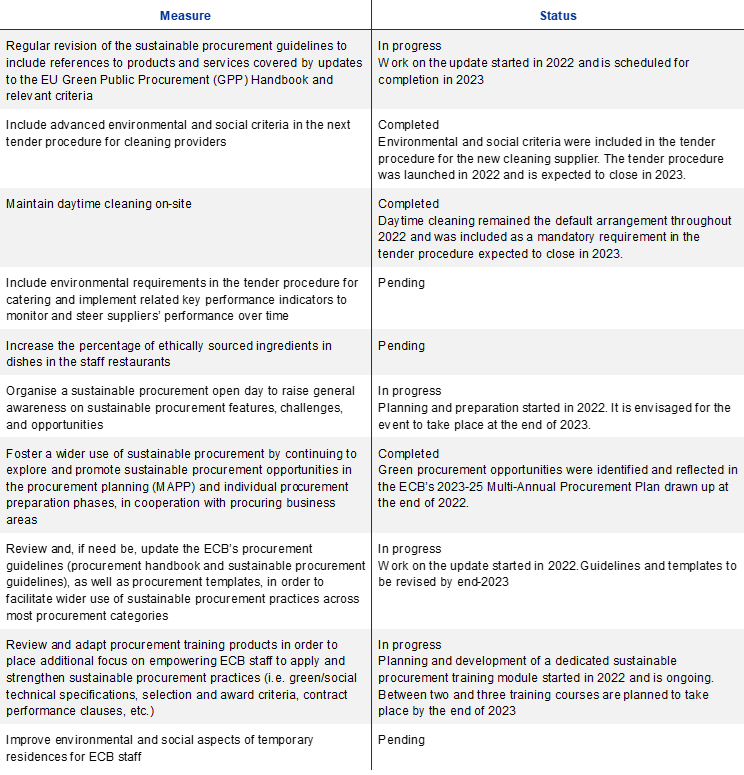
Notes: “Completed” = measure completed; “In progress” = measure in progress; “Pending” = measure still to be implemented.

Procurement is of great relevance for the ECB’s environmental management system, given the potential to steer the integration of sustainability aspects into procurement processes and specifications, as well as the ECB’s value chain.
In 2022 the ECB conducted 307 new procurement procedures, of which 54 are considered to be “green procurement procedures”, in which environmental considerations were incorporated, for example in the procurement specifications for a waste disposal supplier and a cleaning service supplier. As such 18% of all new procurements in 2022 were green procurements, which is comparable to the 2021 figure of 18.2%. Similarly, in value terms, procurement procedures that included environmental considerations accounted for 27% of the total value of all new procurement procedures in 2022, which is a 6 percentage point increase on 2021.
In 2022 all 64 public tender procedures and 97 three-five quote procedures were conducted via electronic means (via the ECB’s e-tendering platform, ASTRA, other electronic means of e-communication and e-submission). The full implementation of an electronic end-to-end procurement process affords considerable environmental gains in terms of paper consumption, printing consumables, packaging material and shipping emissions. In addition, the ECB continues to hold supplier meetings almost exclusively virtually in order to reduce emissions stemming from the travel of suppliers to the ECB. Moreover, electronic signatures remain standard practice for contracts, thereby also supporting material efficiency and energy reduction objectives. In 2022 almost all contracts, purchase orders and outcome letters, with only a few exceptions, were signed digitally at the ECB.
Training and awareness-raising activities on green procurement were again offered to ECB procurement practitioners. In 2022, 14 ECB staff members participated in the online procurement training course on drafting green specifications, and 28 procurement staff members attended a divisional meeting on promoting green procurement in the ECB. A dedicated training video on sustainable procurement and an associated presentation have been made available to all staff on the ECB’s internal web-based environment.
Together with other European institutions, the ECB takes part in a joint activity regarding a Green Public Procurement Helpdesk. The participating institutions benefit from the Helpdesk’s database, best practices and market knowledge on green procurement. From 2022 the scope of the Helpdesk was expanded to include a social responsibility dimension.
4.9 Travel

Travel activities in 2022 grew considerably compared with 2020 and 2021, largely owing to the lifting of pandemic-related travel restrictions from June onwards. Nevertheless, travel-related emissions remained well below pre-pandemic levels. Compared with 2019, business travel emissions in 2022 were 64.2% lower and accounted for 2,770 tonnes CO2e.[6] Aviation-related travel remains the largest source of emissions, accounting for 95.9% of all business travel emissions in 2022.
Owing to a change of travel services provider, the data on business travel for the first three months of 2022 are incomplete. Proxy data based on available travel emission data from April are instead used to cover that period, since the same travel restrictions were still applicable at that time.
As the increase in travel-related activities was expected, the ECB included travel objectives and measures in its Environmental Management Programme to limit a strong rebound effect. Most measures have been implemented as of 2023 and include an update of the internal travel rules to favour rail travel over air travel for specific routes.
Conference activities at the ECB started up again in 2022 after a long halt owing to pandemic-related restrictions. Emissions from the travel of conference participants to the ECB accounted for 1,180.1 tonnes of CO2e in 2022, which was still significantly lower than 2019 levels (-89.1%). Steps were taken to reduce the impact of meetings at the ECB by targeting a 50% reduction of physical meetings and conferences with external participants over a two-year period (2023-24). Specifically, additional and more advanced hybrid technology was installed in meeting rooms across the ECB. To facilitate the uptake of this technology, increased training and support was provided to users in the form of informative videos, dedicated hands-on sessions, and a hybrid meeting toolkit. The ECB also published an internal guideline on sustainable events to reduce the impact of physical conferences. For further details on the status of these measures, refer to Chapter 3 ‒ The ECB’s carbon footprint.
Data on staff commuting and teleworking are subject to a higher degree of uncertainty as a result of the changing working modalities and available datasets. It therefore has to be interpreted with caution, in particular for the period since 2020, as commuting patterns have constantly evolved, and information sources changed. Teleworking and commuting emissions are calculated on the basis of a staff survey that was launched in 2021 and is repeated every two years. The next staff survey is scheduled to take place in 2023. In 2022 the calculation of teleworking emissions was refined, as data on the daily occupancy levels on ECB’s premises became available, allowing for more accurate estimations of staff teleworking. Besides commuting patterns, the survey focuses on the incremental energy use related to remote working (for example office devices such as laptops, monitors, desktop computers, phones, tablets, etc., as well as lighting, cooling and heating). The largest share of teleworking emissions stems from heating, at 78.3%. In 2022 emissions from teleworking and commuting fell by 22.7% compared with 2021, most likely due to the more accurate calculation of on-site presence, which was overestimated for 2021, as it was exclusively based on survey data (for example it did not exclude sick days, absences due to business travel, etc. from the calculation) and the mandatory office days paired with the requirement to reside in the Frankfurt area, which led to a reduction in the assumptions used for commuting distances. Additionally, teleworking emissions were reduced as staff were entitled to fewer teleworking days under the new policy. From January 2023 the ECB decided that remote working should remain an integral part of working life at the bank, granting a maximum of 110 teleworking days per calendar year. The decision was taken following an interim trial period between May and December 2022 during which a minimum number of eight on-site working days per month was set, following the first four months of the year, when most staff members worked remotely.
The greenhouse gas emissions associated with teleworking and commuting are described in Chapter 3.2 ‒ Indirect emissions.
4.10 Communication, engagement and awareness-raising



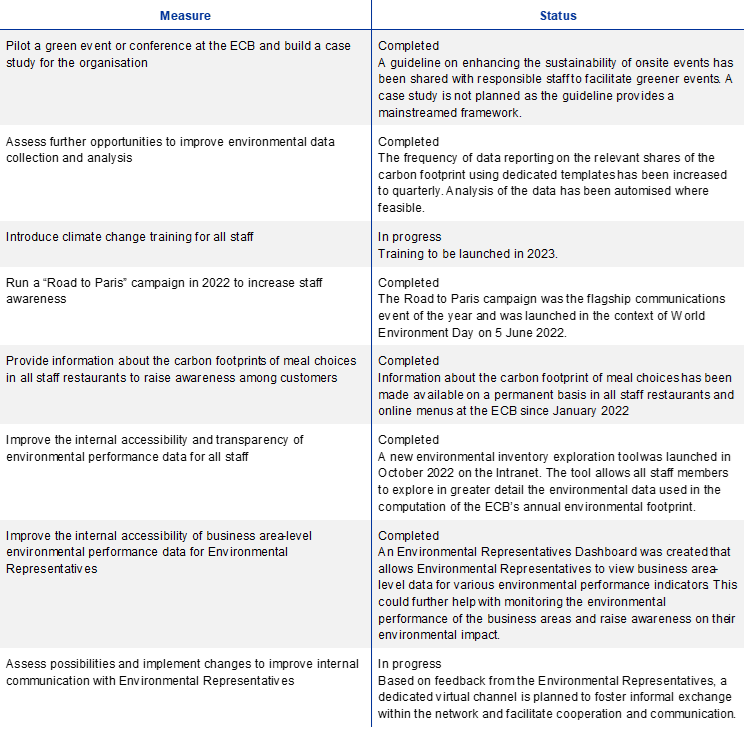
Note: “Completed” = measure completed; “In progress” = measure in progress; “Pending” = measure still to be implemented.
2022 proved to be a very dynamic and fruitful year for the ECB’s environmental communication strategy, and plenty of awareness-raising activities were carried out both online and on-site.
In February 2022 the ECB celebrated the 2022 Interinstitutional EU Eco-Management and Audit Scheme (EMAS) days. These included a wide range of interesting environment-related events. The ECB contributed to many of the events, giving several presentations on climate neutrality strategies, the organisation of sustainable conferences and events, and empowerment for staff awareness and engagement.
On the occasion of the World Wildlife Fund’s Earth Hour in March 2022, the ECB showed its support by joining the event for the eleventh consecutive year. During Earth Hour, all non-essential lights across all three ECB locations were switched off, in addition to the regular evening switch-off schedule, to raise awareness about the challenges posed by climate change. The event was supported by the ECB’s catering service providers, who introduced several initiatives that helped colleagues celebrate Earth Hour at home or in the office.
The Road to Paris campaign was the flagship communications event throughout 2022. To celebrate World Environment Day on 5 June, the Green ECB team launched the Road to Paris campaign initiating a friendly competition among staff members and encouraging environmentally friendly behaviour to accompany the ECB on its journey to reach the Paris-aligned objectives.
The internal challenge included the use of an app where colleagues could learn more about their personal environmental footprint and complete challenges to reduce it. To earn points, staff members were invited to complete different challenges which involved incorporating environmentally friendly behaviours in everyday life activities. The categories included shopping behaviour, business, nutrition, living, mobility, leisure and digital life.
The campaign was designed to directly support the emissions reduction trajectory necessary to meet the 2030 objectives, by rewarding environmentally conscious behaviours that reduced the carbon footprint of ECB staff. By introducing a gamified element to the communication activities, combined a longer overall duration, the aim was to keep staff engagement high as they participated in new and exciting activities.
Throughout the campaign, which lasted until October 2022, five videos were filmed to provide more information to staff about different areas of action by the ECB. These highlighted biodiversity measures, waste management, the newly established in-house print centre, health and environmental activities within the catering services, and sustainable transport and commuting options at the ECB.
In addition, three themed sprint challenges were launched during the campaign, which gave participants the opportunity to obtain additional points while also providing tips on how to be more environmentally friendly at home and in the office. The sprint challenges focused on energy saving, waste reduction and responsible consumption, as well as sustainable mobility and travel. Each sprint had a business area winner. The three sprint champions were recognised alongside the overall campaign victors from among the business areas and the winning team during the closing ceremony in November.
At the closing ceremony of the Road to Paris campaign, organised in the context of the ECB Climate Days launched by the climate change centre, President Lagarde awarded the winners of the Road to Paris campaign.
Thanks to participants’ commitment to the campaign and the ensuing completion of over 3,100 challenges involving staff from almost all of the ECB’s business areas, 92.2 tonnes of CO2e were saved during the five-month campaign. The completion of the top two most popular challenges alone contributed savings of approximately 18 tonnes of CO2e. This shows that even seemingly small actions, when done consistently and frequently, can end up having a large impact.
“Better connections” was the theme and key message of the European Mobility Week that took place in September 2022. The ECB participated in this annual awareness-raising campaign organised by the European Commission by promoting several options for sustainable mobility (bicycle parking infrastructure, Deutsche Bahn “Call-a-Bike” scheme and RMV Job Ticket[7]). During that week, free bicycle safety checks were also again offered to ECB staff members.
In 2022 the European Week for Waste Reduction focused on the topic of the circular economy and sustainable textiles. Over the course of a week in November several awareness-raising actions about sustainable resource and waste management were carried out across Europe, with a spotlight on recycling in the textile sector. Activities ranged from clean-up actions and waste-sorting gatherings to recycling drives and sessions on preparing materials for re-use. At the ECB, staff members could test their knowledge on the sustainability of the fashion industry through a quiz, in the process learning more about the true environmental impact of our fashion choices.
EMS-related activities within the ECB are also supported by the network of Environmental Representatives (ERs). ERs play a crucial role in raising awareness on environmental and sustainability issues. They act as contact persons between their business areas and the Environmental Coordinator and Green ECB team on relevant environmental topics and help implement the EMS in their business area. As usual, in 2022 ERs ran individual awareness-raising activities and events, focusing on energy saving, “green challenges” that involved revisiting habits and actions in everyday life, greener teambuilding options, as well as ways of reducing household waste. The Environmental Representatives Dashboard was also rolled out in 2022. The Dashboard allows ERs to view business area-level data on various environmental performance indicators, aimed at enhancing the monitoring of business areas’ environmental performance and raising awareness on their environmental impact.
Interinstitutional collaboration with other European institutions and Eurosystem central banks focused on developing and exchanging expertise and best practices on environmental management was once again very high on the agenda in 2022. This mainly takes place through the environmental network for European institutions (GIME) and the Environmental Network of Central Banks (ENCB), as well as through bilateral exchanges with peer organisations. In 2022 the ECB achieved its objective to foster interinstitutional collaboration by facilitating at least two ENCB meetings and even exceeded it, since three meetings took place. The meetings took place online in order to set an example and reduce travel-related emissions beyond the pandemic.
5 Technical information
The previous chapters illustrated the main environmental developments and measures undertaken by the ECB. This chapter presents additional information on the ECB’s environmental performance in accordance with the requirements set out in the EMAS regulation.[8]
Workplace overview

Source: ECB.
Notes: Workplace indicators are reported as a requirement for EMAS. It should be noted that a slight bias exists compared with pre-pandemic years owing to the updated teleworking policies. Not all workplaces are occupied on a day-to-day basis. Thus, workplace indicators do not fully represent actual developments.
5.1 Updates to conversion factors
The table below presents the percentage differences of CO2e emission conversion factors used to calculate the emissions for 2021 and 2022 (for more information, see Chapter 3 – The ECB’s carbon footprint). Although most emission factors are updated annually, only those factors that have changed by more than 5% compared with 2021 are listed in the table. This overview gives further information on the developments set out in this statement. The year-on-year differences are calculated based on the most recent factors from the corresponding sources.

Location-based emissions

Note: The ECB reports its emissions in accordance with the marked-based approach, which allows the use of emission factors from contractual instruments. For example the ECB accounts for zero emissions in scope 2 as it uses a certified renewable electricity supply for all premises. Upstream emissions from renewable electricity consumption are included in the calculation of scope 3 emissions. As the Greenhouse Gas Protocol recommends also reporting following the location-based approach, the ECB additionally calculates and displays emissions from electricity use, based on the emission factor for the German electricity mix.
5.2 Workplace-based environmental performance indicators 2020-22


Note: Includes consumption of other paper products such as letterheads, calendars and notepads.

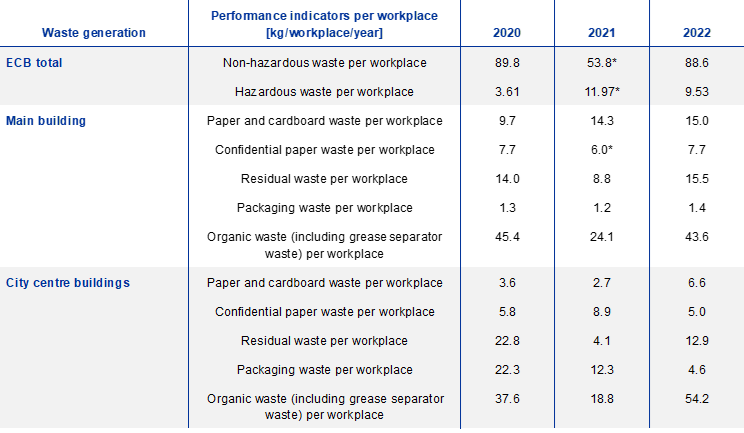
Notes: *The performance indicators for non-hazardous waste and hazardous waste per workplace for 2021 were adjusted on the basis of an improvement in the monitoring and reporting process. The non-hazardous waste indicator was adjusted from 57.8 kg to 53.8 kg, and the hazardous waste indicator from 12.0 kg to 11.97 kg.

Notes: *Biogas for heating in the Eurotower replaced natural gas as of 2022. Biogenic emissions from biogas were added outside of scope. Waste emissions were adjusted from 1.6 kg to 1.2 kg in 2021. In 2021 purchased goods and services emissions were adjusted from 177.9 kg to 180.9 kg, and other assets emissions from 183.5 kg to 194.4 kg. Total scope 3 emissions per workplace changed from 2,018.1 kg to 2,031.6 kg in 2021. CO2e emissions per workplace were adjusted from 3,015 kg to 3,029 kg in 2021. These changes resulted from an improvement in the monitoring and reporting process.


Note: *The performance indicator for NOx per workplace was adjusted from 0.141 kg to 0.142 kg for 2020 and from 0.145 kg to 0.146 kg for 2021 based on an improvement in the monitoring and reporting process.

5.3 Uncertainty assessment of the ECB’s carbon footprint 2022
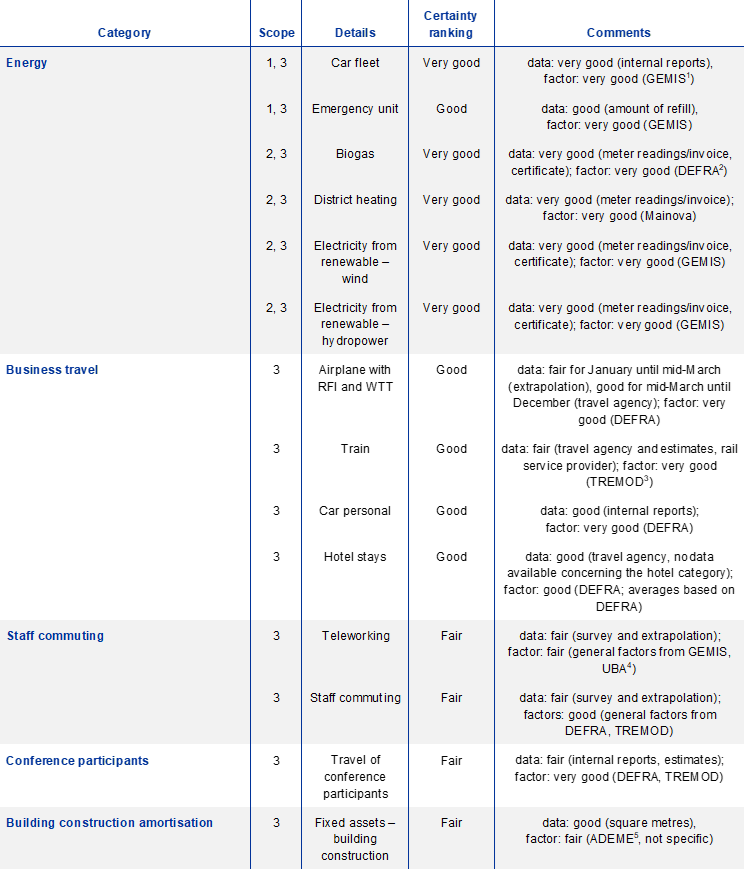
1) Global Emission Model for Integrated Systems (GEMIS)
2) Department for Environment, Food and Rural Affairs (DEFRA)
3) Transport Emission Model (TREMOD)
4) German Federal Environment Agency (UBA)
5) French Environmental and Energy Management Agency (ADEME)

Note: Changes to the previous certainty ranking are marked in bold.
1) German Institute for Energy and Environmental Research (IFEU)
The following ranking was applied to estimate the uncertainty of the activity data and the emission factors.
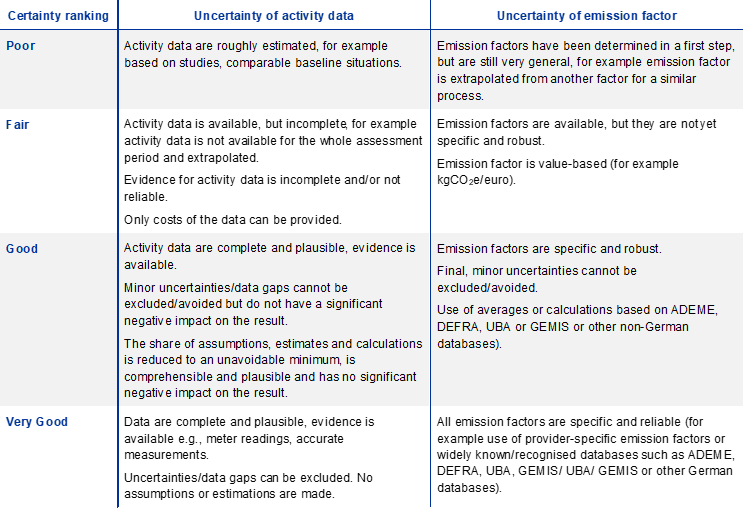
5.4 Compliance obligations

The environmental compliance obligations to be met by the ECB are defined by regulations at the municipal and German levels and are summarised in a register that is regularly reviewed and updated by legal experts. Changes and required measures are carefully monitored to ensure that all environmental regulations are met. Most of the ECB’s compliance obligations are connected to the operation and maintenance of its buildings and contracted services, such as cleaning and catering. Annual internal environmental audits are conducted to evaluate the ECB’s compliance with these regulations. No deviations from the legal requirements were detected in the latest assessments.
Table 2
Relevant areas of environmental legislation and related facilities/activities
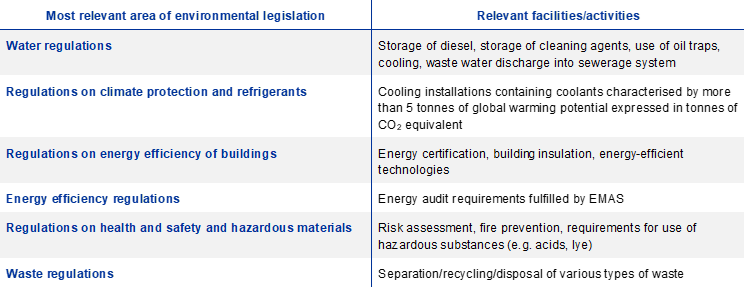
In addition to its obligations under environmental law, the ECB is also committed to additional environmental obligations. These include the Sustainable Procurement Guidelines and the objectives of the Environmental Management Programme. Additionally, a variety of communication campaigns raise awareness of environmental issues among ECB staff.
Further information on climate change and on the related action by the ECB within its mandate is available on the ECB’s website.
6 Environmental verifier’s declaration
The environmental verifiers named below confirm that the European Central Bank (ECB) premises at Sonnemannstrasse 20, 60314 Frankfurt am Main, Germany (main building), Taunustor 2, 60311 Frankfurt am Main, Germany (Japan Center) and Kaiserstrasse 29, 60311 Frankfurt am Main, Germany (Eurotower), as described in this Environmental Statement by the ECB (which has the registration number DE-125-00045), meet all the requirements laid down in Regulation (EC) No 1221/2009 of the European Parliament and of the Council of 25 November 2009, as amended on 28 August 2017 and 19 December 2018, on the voluntary participation by organisations in a Community Eco-Management and Audit Scheme (EMAS).

In signing this declaration, we confirm that:
- the assessment and validation have been carried out in full compliance with the requirements of Regulation (EC) No 1221/2009 as amended by Commission Regulation (EU) 2017/1505 and (EU) 2018/2026;
- the result of the assessment and validation confirms that there is no evidence of non-compliance with applicable environmental legislation;
- the data and information in this Environmental Statement provide a reliable, credible and accurate picture of all the organisation's activities.
This declaration cannot be equated with EMAS registration. EMAS registration can only be carried out by a competent body in accordance with Regulation (EC) No 1221/2009. This declaration may not be used as a stand-alone piece of public communication.
Frankfurt am Main, 14 June 2023
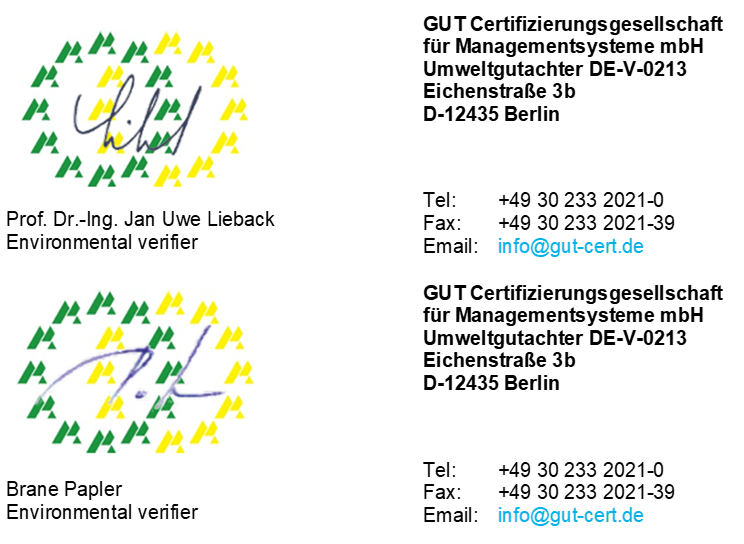
Disclaimer

This ECB Environmental Statement provides information to the general public and other interested parties about the environmental performance and activities of the European Central Bank (ECB) in 2022. It can be found on the ECB’s website (see the page entitled “Environmental protection at the ECB”).
The ECB was first validated under the EU Eco-Management and Audit Scheme (EMAS) in 2010. This Environmental Statement, which is the 14th to be produced within the EMAS validation cycle, is a follow-up to the consolidated Environmental Statement for 2022. It is only complete when read together with this publication and contains updated data for the year 2022.
This Environmental Statement was drafted in line with EMAS standards in accordance with Regulation (EC) No 1221/2009 and the updated annexes of the EMAS Regulation in accordance with Regulation (EC) No 2017/1505.
© European Central Bank, 2023
Postal address 60640 Frankfurt am Main, Germany
Telephone +49 69 1344 0
Website www.ecb.europa.eu
All rights reserved. Reproduction for educational and non-commercial purposes is permitted provided that the source is acknowledged.
For specific terminology please refer to the ECB glossary (available in English only).
As of 1 September 2022, the German government published its energy conservation ordinances to support the European Commission’s Gas Demand Reduction Plan.
Under the Deutsche Bahn certificate, direct emissions are covered by the use of renewable energy certificates and therefore accounted as zero, while upstream (well-to-tank) emissions are 100% compensated. Owing to a lack of data on the upstream energy consumption per km and the related emission factors, these emissions are currently not accounted for under scope 3 emissions.
Well-to-tank emissions are upstream emissions stemming from the production, processing and delivery of fuels.
In relation to air travel, radiative forcing is defined as “[…] the sum of all forcings, including direct emissions (e.g. CO2, soot) and indirect atmospheric responses (e.g. CH4, O3, sulfate, contrails)” and as such, the radiative forcing index (RFI) is “[…] a measure of the importance of aircraft-induced climate change other than that from the release of fossil carbon alone.” (Source: IPCC: “Aviation and the Global Atmosphere”, https://archive.ipcc.ch/ipccreports/sres/aviation/index.php?idp=71, last accessed 17/04/2023, 16:13)
Biogenic emissions are CO₂ emissions arising from biomass combustion and are tracked separately from fossil CO₂e emissions.
including radiative forcing for aviation and well-to-tank emissions for air and motor vehicle travel.
In 2022 the ECB offered its staff a ticket for the local public transportation service (RMV) at a reduced price.


